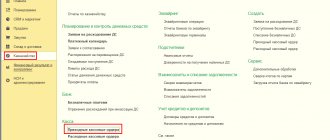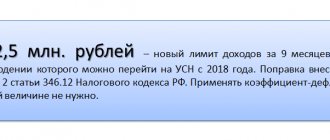Source: Journal “Autonomous Institutions: Accounting and Taxation”
Article 143 of the Tax Code of the Russian Federation classifies Russian organizations, in particular autonomous institutions, as VAT payers. The procedure for taxation of paid services provided by a state (municipal) institution is quite clearly regulated by current regulatory documents. In this article, we will consider the accounting of transactions related to the calculation and payment of VAT, taking into account the changes made to Instruction No. 157n by Order of the Ministry of Finance of the Russian Federation dated August 29, 2014 No. 89n.
VAT changes from 2022
From January 1, 2019, a new VAT rate is in effect in the Russian Federation - 20%.
Now all sales, receipts and other transactions must be subject to 20% VAT. This rate must also be indicated when describing VAT in invoices and books of purchases and sales. VAT rates of 10% and 0% continue to apply and tax goods, works and services in situations established by law. VAT must be transferred to the budget at the new rates from 01/01/2019. Accounting entries for VAT are compiled for transactions with a 20% value added tax according to the same rules as before, nothing has changed.
BCC for transferring value added tax to the budget in 2020 for legal entities - 182 1 0300 110. All BCCs operating in 2020:
Accounting for VAT calculations: pay attention to changes
By virtue of Order of the Ministry of Finance of the Russian Federation dated November 16, 2016 No. 209n, the plans of accounts of state, budgetary and autonomous institutions were supplemented with a new account - 0 210 13 000 “Calculations for VAT on advances paid.”
The material analyzes the procedure for reflecting VAT calculations in the accounting (budget) accounting of sports institutions using the specified account 02/01/2017 Author: L. Lartseva
ABOUT PAYMENT OF VAT BY SPORTS INSTITUTIONS.
First of all, let’s find out whether sports institutions are considered VAT payers.
As a general rule, all organizations, including sports institutions, are VAT payers (Clause 1, Article 143 of the Tax Code of the Russian Federation).
However, in relation to certain transactions, these institutions are exempt from paying tax. Such operations include:
- provision of services to the population for the organization and conduct of physical education, sports, recreational and sports events (Clause 14.1, Clause 2, Article 149 of the Tax Code of the Russian Federation). When qualifying such services, it is necessary to use the concepts and terms contained in the Federal Law dated December 4, 2007 No. 329-FZ “On Physical Culture and Sports in the Russian Federation” (letter of the Federal Tax Service of the Russian Federation dated November 8, 2016 No. SD-4-3/ [email protected ] , Ministry of Finance of the Russian Federation dated 04/13/2015 No. 03-07-07/20872, dated 02/03/2015 No. 03-07-07/4071);
- provision of services for conducting classes with minor children in sports sections (clause 4, clause 2, article 149 of the Tax Code of the Russian Federation);
- sale of entrance tickets and subscriptions, the form of which is approved in the prescribed manner as a strict reporting form, for sports and entertainment events held by physical culture and sports organizations (clause 13, clause 3, article 149 of the Tax Code of the Russian Federation);
- provision of services for the rental of sports facilities for the preparation and holding of sports and entertainment events (clause 13, clause 3, article 149 of the Tax Code of the Russian Federation).
In addition, if a sports institution is state-owned, operations involving the performance (provision) of any work (services) by this institution are not recognized as subject to VAT. A budgetary (autonomous) institution is not subject to taxes on operations for the performance of work (provision of services) within the framework of a state (municipal) assignment, the source of financial support of which is a subsidy from the corresponding budget of the budgetary system of the Russian Federation (clause 4.1, clause 2, article 146 of the Tax Code of the Russian Federation).
Also based on paragraphs. 5 p. 2 art. 146 of the Tax Code of the Russian Federation are not subject to VAT on the transfer on a gratuitous basis, the provision of services for the transfer for free use of fixed assets to state authorities and management and local governments, state (municipal) institutions or unitary enterprises.
For operations not classified as listed above, sports institutions are required to calculate VAT in the generally established manner. Taxable transactions include, in particular:
- rental of sports equipment;
- sale of sports paraphernalia and souvenirs;
- additional paid services of sauna, massage;
- provision of space for rent not related to the preparation and holding of sports and entertainment events (for organizing a catering facility, a store, an office, a point for providing personal services, etc.).
If in the three previous calendar months the amount of revenue from the sale of goods (work, services) did not exceed 2 million rubles, then the institution may exercise the right to be exempt from VAT payer obligations on the basis of Art. 145 Tax Code of the Russian Federation.
VAT CHARGING.
In accordance with paragraph 1 of Art. 154 of the Tax Code of the Russian Federation, when selling goods (work, services), the VAT base is defined as the cost of these goods (work, services) taking into account excise taxes (for excisable goods) and without including tax.
In accounting, accrued VAT amounts are reflected in account 0 303 04 000 “Calculations for value added tax” (clause 263 of Instruction No. 157n[1]). This account is used in correspondence with the debit of accounts (clauses 104, 121 of Instruction No. 162n[2], clauses 131, 151 of Instruction No. 174n[3], clauses 159, 179 of Instruction No. 183n[4]):
- 1 401 20 290 “Other expenses” for government institutions. Thus, the amounts of VAT payable to the budget increase the institution’s expenses;
- 0 401 10 130 “Income from the provision of paid services”, 0 401 10 180 “Other income” from budgetary (autonomous) institutions. Thus, in these institutions, VAT amounts are applied to the reduction of income. The use of a particular account, or rather the KOSGU code indicated in the 24th to 26th digits of the account number, is established by the institution independently as part of the formation of its accounting policy.
Payment of VAT to the budget is reflected in accounting records as the debit of account 0 303 04 000 in correspondence with the credit of accounts (clause 104 of Instruction No. 162n, clause 133 of Instruction No. 174n, clause 161 of Instruction No. 183n):
- 1 304 05 290 “Settlements for payments from the budget with the financial authority for other expenses” for state institutions;
- 0 201 11 000 “Cash in the personal accounts of the institution in the treasury body” with budgetary (autonomous) institutions.
VAT is calculated based on the invoice issued to the buyer. The VAT amount is written on the invoice as a separate line (clauses 3, 4, Article 168 of the Tax Code of the Russian Federation).
When selling goods for cash, as well as providing paid services directly to the population, the requirements for preparing payment documents and issuing invoices are considered fulfilled if the seller issues the buyer a cash receipt or other document of the established form (Clause 7 of Article 168 of the Tax Code of the Russian Federation). In these cases, VAT is calculated, according to the author, on the basis of a completed accounting certificate (f. 0504833).
TAX DEDUCTIONS FOR VAT.
In accordance with Art. 171 of the Tax Code of the Russian Federation, the taxpayer has the right to reduce the calculated amount of tax by corresponding tax deductions. The specifics of the application of such deductions are established by Art. 172 of the Tax Code of the Russian Federation.
To maintain accounting of calculations for deductions of VAT amounts, analytical accounts opened for account 0 210 10 000 “Calculations for tax deductions for VAT” are used. What these accounts are and what tax deductions they are intended to reflect are reflected in the table.
| Account number and name | Tax deduction |
| 0 210 11 000 “Calculations for VAT on advances received” | Based on clause 8 of Art. 171 of the Tax Code of the Russian Federation, tax amounts calculated by the taxpayer-seller from the amounts of payment (partial payment) received from the buyer for upcoming deliveries of goods (performance of work, provision of services) are subject to deductions. These deductions are made from the date of shipment of the relevant goods (performance of work, provision of services) in the amount of tax calculated from the cost of goods shipped (work performed, services rendered), in payment for which the amount of previously received payment (partial payment) is subject to offset according to the terms of the agreement (if the presence of such conditions) (clause 6 of article 172 of the Tax Code of the Russian Federation). That is, VAT calculated |
| calculated from the prepayment received is subject to deduction in the tax period in which the goods (work, services) were shipped. As with the shipment of goods, upon receipt of an advance payment, the seller is obliged to issue an invoice to the buyer no later than the next five calendar days (clauses 1, 3 of Article 168 of the Tax Code of the Russian Federation) | |
| 0 210 12 000 “Calculations for VAT on purchased material assets, works, services” | In accordance with paragraph 2 of Art. 171 of the Tax Code of the Russian Federation, tax amounts presented to the taxpayer when purchasing goods (work, services) for the implementation of VAT-taxable transactions are subject to deductions. Such amounts based on clause 1 of Art. 172 of the Tax Code of the Russian Federation are subject to deduction after registration of purchased goods (works, services) and in the presence of relevant primary documents. It is worth noting that these tax deductions can be claimed in tax periods within three years after the registration of goods (work, services), property rights acquired by the taxpayer in the territory of the Russian Federation (clause 1.1 of Article 172 of the Tax Code of the Russian Federation) |
| 0 210 13 000 “Calculations for VAT on advances paid” | By virtue of clause 12 of Art. 171 of the Tax Code of the Russian Federation, the VAT amounts presented by the seller of these goods (works, services), property rights are subject to deductions from the taxpayer-buyer who transferred the amounts of payment (partial payment) on account of the upcoming supply of goods (performance of work, provision of services), transfer of property rights. These deductions are made on the basis of invoices issued by sellers upon receipt of payment (partial payment) for upcoming deliveries of goods (performance of work, provision of services), documents confirming the actual transfer of payment amounts, partial payment for upcoming deliveries of goods (performance of work, provision of services), in the presence of an agreement providing for the transfer of the specified amounts (clause 9 of Article 172 of the Tax Code of the Russian Federation) |
Below we present the correspondence of accounts for reflecting tax deductions for VAT in accounting (budget) accounting (clauses 88, 104 of Instruction No. 162n, clauses 112, 113, 131 of Instruction No. 174n, clauses 115, 116 of Instruction No. 183n).
| State institution | State-financed organization | Autonomous institution | |||
| Calculation of VAT on advances received | |||||
| 1 210 11 560 | 1 303 04 730 | 0 210 11 560 | 0 303 04 730 | 0 210 11 000 | 0 303 04 000 |
| Reducing the amount of VAT payable to the budget by the amount of tax accrued upon receipt of payment (partial payment) for upcoming supplies of goods (performance of work, provision of services) | |||||
| 1 303 04 830 | 1 210 11 660 | 0 303 04 830 | 0 210 11 660 | 0 303 04 000 | 0 210 11 000 |
| Accrual of tax presented to the institution by suppliers (contractors) on acquired non-financial assets (work performed, services rendered) or actually paid when importing non-financial assets into the territory of the Russian Federation, not included in the cost of such non-financial assets (work, services) | |||||
| 1 210 12 560 | 1 208 xx 660* 1 302 xx 730 | 0 210 12 560 | 0 208 xx 660 0 302 xx 730 | 0 210 12 000 | 0 208 xx 000 0 302 xx 000 |
| Write-off of VAT amounts accepted by the institution as a tax deduction | |||||
| 1 303 04 830 | 1 210 12 660 | 0 303 04 830 | 0 210 12 660 | 0 303 04 000 | 0 210 12 000 |
| Write-off of VAT amounts for increasing the cost of non-financial assets (works, services) in the manner prescribed by the tax legislation of the Russian Federation (in terms of the cost of finished products, works, services) | |||||
| 1 106 34 340 1 109 00 000 | 1 210 12 660 | 0 109 00 000 | 0 210 12 660 | 0 109 00 000 | 0 210 12 000 |
| Offsetting the amount of VAT accepted for deduction on prepayment transferred against upcoming supplies of goods (performance of work, provision of services), transfer of property rights | |||||
| 1 210 13 560 | 1 210 12 660 | 0 210 13 560 | 0 210 12 660 | 0 210 13 000 | 0 210 12 000 |
| Reducing the amount of VAT payable to the corresponding budget of the budget system of the Russian Federation by the amount of tax on the transferred advance payment on account of upcoming supplies of goods (performance of work, provision of services), transfer of property rights presented by the seller of these goods (work, services), property rights | |||||
| 1 303 04 830 | 1 210 13 660 | 0 303 04 830 | 0 210 13 660 | 0 303 04 000 | 0 210 13 000 |
*Hereinafter, instead of the “xx” symbol, the corresponding analytical code is indicated.
A budgetary sports institution rents out an ice arena for holding an ice show by a third party. This activity is subject to VAT at a rate of 18%. The total rent amounted to RUB 300,000. (including VAT - 45,763 rubles). According to the terms of the agreement, a third-party organization transferred part of the rent to the institution’s personal account for the upcoming provision of services in the amount of 100,000 rubles. (including VAT - 15,254 rubles).
According to the adopted accounting policy, the amount of VAT is reflected in the reduction of income under code 130 “Income from paid services (work)”.
In the accounting records of the institution, these transactions will be reflected as follows:
| Contents of operation | Debit | Credit | Amount, rub. |
| Advance payment for ice arena rental has been deposited into the institution's personal account. | 2 201 11 560 Off-balance sheet account 17 (income code 120) | 2 205 21 660 | 100 000 |
| VAT is charged on the received prepayment | 2 210 11 560 | 2 303 04 730 | 15 254 |
| Accrued rental income | 2 205 21 560 | 2 401 10 120 | 300 000 |
| VAT charged on total income | 2 401 10 130 | 2 303 04 730 | 45 763 |
| Accepted for deduction of VAT previously allocated from the prepayment received | 2 303 04 830 | 2 210 11 660 | 15 254 |
| VAT transferred to the budget | 2 303 04 830 | 2 201 11 660 Off-balance sheet account 18 (income code 130) | 45 763 |
The autonomous sports institution provides skate rental services. These transactions are subject to VAT at a rate of 18%. The total rental income was 70,000 rubles. (including VAT – 10,678 rubles).
In order to update existing sports shoes intended for rental, the institution entered into an agreement for the supply of new skates for a total amount of 20,000 rubles. (including VAT - 3,051 rubles). Previously, under the supply agreement, the institution transferred an advance in the amount of 6,000 rubles. (including VAT - 915 rubles).
According to the adopted accounting policy, the amount of VAT is reflected in the reduction of income under code 130 “Income from paid services (work)”.
In the accounting records of the institution, these transactions will be reflected as follows:
| Contents of operation | Debit | Credit | Amount, rub. |
| The rental fee has been handed over to the institution's cash desk. | 2 201 34 000 | 2 205 20 000 | 70 000 |
| Rental income accrued | 2 205 20 000 | 2 401 10 120 | 70 000 |
| VAT is charged on the amount of income | 2 401 10 130 | 2 303 04 000 | 10 678 |
| An advance payment was made to the supplier for skates intended for rental | 2 206 34 000 | 2 201 11 000 Off-balance sheet account 18 (KVR 244/340 KOSGU) | 6 000 |
| The amount of VAT on the transferred advance has been allocated | 2 210 13 000 | 2 210 12 000 | 915 |
| The delivery of skates is reflected (excluding VAT) (20,000 - 3,051) rub. | 2 105 36 000* | 2 302 34 000 | 16 949 |
| The amount of VAT presented by the supplier upon receipt of skates has been highlighted | 2 210 12 000 | 2 302 34 000 | 3 051 |
| The previously transferred advance has been credited | 2 302 34 000 | 2 206 34 000 | 6 000 |
| The final payment has been made to the supplier (20,000 - 6,000) rub. | 2 302 34 000 | 2 201 11 000 Off-balance sheet account 18 (KVR 244/340 KOSGU) | 14 000 |
| VAT submitted by the supplier is accepted for deduction: | |||
| in the amount allocated when transferring an advance payment to the supplier for the upcoming delivery of skates | 2 303 04 000 | 2 210 13 000 | 915 |
| in the amount allocated upon delivery of skates, with the tax amount offset against the advance payment (3,051 - 915) rub. | 2 303 04 000 | 2 210 12 000 | 2 136 |
| VAT transferred to the budget (10,678 - 915 - 2,136) rub. | 2 303 04 000 | 2 201 11 000 Off-balance sheet account 18 (income code 130) | 7 627 |
*Items intended for rental, regardless of their cost, are taken into account as part of material inventories (clause 99 of Instruction No. 157n).
* * *
Despite the fact that the main activities of sports institutions are exempt from VAT, many of the additional paid services they provide are subject to this tax in accordance with the generally established procedure. When reflecting VAT calculations in accounting, it is necessary to take into account the latest changes introduced by Order No. 209n. According to these changes, a new account 0 210 13 000 was introduced, intended to reflect VAT calculations on advances paid.
[1] Instructions for the application of the Unified Chart of Accounts for public authorities (state bodies), local governments, management bodies of state extra-budgetary funds, state academies of sciences, state (municipal) institutions, approved. By order of the Ministry of Finance of the Russian Federation dated December 1, 2010 No. 157n.
[2] Instructions for the use of the Chart of Accounts for Budget Accounting, approved. By order of the Ministry of Finance of the Russian Federation dated December 6, 2010 No. 162n.
[3] Instructions for the use of the Chart of Accounts for accounting of budgetary institutions, approved. By order of the Ministry of Finance of the Russian Federation dated December 16, 2010 No. 174n.
[4] Instructions for the use of the Chart of Accounts for accounting of autonomous institutions, approved. By order of the Ministry of Finance of the Russian Federation dated December 23, 2010 No. 183n.
Ayudar-press
Post:
Comments
How to Prepare Accounting Entries
VAT accounting is carried out according to the following accounts in the chart of accounts (Order of the Ministry of Finance of the Russian Federation No. 94n dated October 31, 2000):
- 68 “Calculations for taxes and fees”, subaccount 68.02 - accrual is recorded on the loan, VAT calculated and paid to the budget is carried out according to Dt 68;
- 19 “Value added tax on acquired assets” - to reflect input VAT, but not reimbursed from the budget.
If an organization is engaged in the sale of goods, works and services, then VAT is charged on the operation - the posting will be: Dt 90, 91 Kt 68.
When purchasing products, the customer has the opportunity to recover VAT from the funds paid to the budget. The procedure is carried out as follows: the paid amount of VAT is separated from the purchase price and recorded in account 19:
- Dt 19 Kt 60 - VAT on acquired assets is accepted for accounting;
- Dt 68 Kt 19 - VAT deductible (posting).
VAT to be refunded is accumulated on the debit of account 68, forming a payment that must be sent to the budget. VAT is the difference between debit and credit turnover. When the turnover on the loan account. 68 exceeds the debit, then the calculated amount of value added tax is subject to payment to the budget. If the debit of the account 68 more than the loan, then the total difference is reimbursed from budget payments.
Budgetary organizations from 2022
In accordance with clause 12.1.7 of the Procedure for the formation and application of budget classification codes of the Russian Federation, approved. by order of the Ministry of Finance of Russia dated 06/08/2020 No. 132n, hereinafter referred to as Procedure No. 132n, operations of taxpayers - state (municipal) autonomous and budgetary institutions for the assessment of taxes, the object of taxation for which is the income (profit) of the institution, for the assessment of value added tax on income from sales made, work performed, services rendered, taxed in accordance with the legislation of the Russian Federation on taxes and fees with value added tax, and on the accrual of corporate income tax calculated based on the results of the tax (reporting) period subject to payment to the budget, are attributed to article of the analytical group of subtype of budget income 180 “Other income”.
on line 030 - the sum of data on the corresponding analytical accounts of account 2 401 10 120 “Property income” minus the amounts of value added tax accrued from this income (on the debit of account 2 401 10 120 “Property income”);
Input VAT
Accounting for input VAT on purchased assets (goods, works, services) is reflected in the following accounting entries:
| Postings | Operation description |
| Dt 19 Kt 60 | Accounting for input VAT on purchased goods, works and services |
| Dt 20 Kt 19 | Write-off of input VAT for those assets that, when used in production processes, are not subject to tax contributions. Such a record is made using a calculation certificate drawn up by an accountant. |
| Dt 91 Kt 19 | VAT on purchased assets was written off as other expenses due to a missing or incorrectly drawn up invoice |
| Dt 20, 23, 29 Kt 68 | VAT recovery - entries for inventories and services that are used for production procedures and are not subject to taxation |
| Dt 68 Kt 19 | For tax deduction |
Features of VAT accounting in budgetary organizations
OBJECTS OF VAT TAXATION, EXEMPTION FROM PAYMENT
Tax is charged in cases where a budgetary institution carries out transactions that are subject to VAT. The list of such operations is given in Art. 146 of the Tax Code of the Russian Federation (hereinafter referred to as the Tax Code of the Russian Federation). These include, in particular:
- sale of goods (works, services, property rights) on the territory of the Russian Federation;
- transfer of goods on the territory of the Russian Federation (performance of work, provision of services) for one’s own needs, the costs of which are accepted for deduction (including through depreciation deductions) when calculating corporate income tax;
- carrying out construction and installation work for own consumption;
- import of goods into the territory of the Russian Federation and other territories under its jurisdiction.
NOTE
Operations that are not subject to VAT are listed in paragraph 2 of Art. 146 of the Tax Code of the Russian Federation.
In accordance with sub. 4.1 clause 2 art. 146 of the Tax Code of the Russian Federation does not recognize the performance of work (provision of services) by budgetary and autonomous institutions within the framework of a state (municipal) assignment, the source of financial support for which is a subsidy from the corresponding budget of the budgetary system of the Russian Federation. In other cases, the performance of work (provision of services) by such institutions is subject to VAT in accordance with the general procedure.
Budgetary organizations can receive exemption from taxpayer obligations as part of fulfilling the requirements of Art. 145 of the Tax Code of the Russian Federation in the following cases:
1) are not engaged in income-generating activities (entrepreneurial activities);
2) for the three previous consecutive calendar months, the amount of revenue from the sale of goods (works, services) of these organizations, excluding VAT, did not exceed a total of 2 million rubles.
Organizations using the right to exemption must submit the appropriate written notification and documents specified in paragraph 6 of Art. 145 of the Tax Code of the Russian Federation, to the tax authority at the place of its registration.
Important detail: notification and documents must be submitted no later than the 20th day of the month from which organizations exercise the right to exemption.
- Documents confirming the right to release (extension of the release period):
- extract from the balance sheet (represented by organizations);
- extract from the sales book;
- an extract from the book of income and expenses and business transactions (represented by individual entrepreneurs).
Exemption from the obligation to pay VAT does not relieve the taxpayer of the duty of a tax agent. If a budget organization is a lessee of federal property, property of constituent entities of the Russian Federation or municipal property, it retains the responsibilities of a tax agent for the calculation, withholding and transfer of VAT to the budget.
IT IS IMPORTANT
Tenants (tax agents) are required to calculate, withhold from income paid to the lessor, and transfer to the budget the appropriate amount of VAT, which is calculated as the product of the rent and the estimated tax rate (clause 4 of Article 164 of the Tax Code of the Russian Federation).
EXAMPLE 1
A healthcare institution rents premises for a bacteriological laboratory and is a tax agent for VAT. Monthly payments under the lease agreement due to subsidies amount to 59,000 rubles.
The amount of VAT in this case can be determined using the calculation method:
59,000 rub. × 18% / 118% = 9000 rub.
The following entries will reflect this in accounting:
Debit account 4.109.70.224 Credit account 4.302.24.730 - 50,000 rub. — the institution’s expenses for rent are reflected;
Debit account 4.109.70.224 Credit account 4.303.04.730 - 9000 rub. — reflects the amount of VAT withheld by the institution as a tax agent.
Thus, under the lease agreement, the institution withheld from the income paid to the lessor the amount of VAT that it is obliged to transfer to the budget. The rental amount excluding VAT is transferred to the lessor (according to the terms of the agreement).
The institution must issue an invoice, which should be reflected in the sales ledger.
SALES OF PROPERTY AND CHARGING VAT
In the activities of a budgetary institution, a situation may arise when, for some reason, unclaimed property appears. In this case, it can be sold by order of a higher organization.
Property is assigned to budgetary institutions with the right of operational management, and therefore can be alienated only by decision of the body to which the state has delegated the rights to dispose of this property.
Based on clause 3 of Art. 298 of the Civil Code of the Russian Federation (hereinafter referred to as the Civil Code of the Russian Federation), a budgetary institution, without the consent of the owner, has no right to alienate or otherwise dispose of property assigned to it by the owner or acquired using funds allocated to it by the owner for the acquisition of such property. The budgetary institution has the right to dispose of the remaining property under its right of operational management independently, unless otherwise established by Federal Law No. 7-FZ dated January 12, 1996 (as amended on December 19, 2016) “On Non-Profit Organizations.”
Regarding property acquired through entrepreneurial activity, the institution is given more rights to realize it.
Tax recovery
VAT recovery is regulated by subparagraphs 1-4, 6, paragraph 3 of Art. 170 Tax Code of the Russian Federation. There are cases in which an organization has the right to restore tax payable to the budget:
- the organization’s property is transferred as a contribution to the authorized capital of a business company, partnership, target capital of an NPO, or as an investment under a relevant agreement;
- purchased GWS are used for operations that are not subject to VAT (clause 2 of Article 170 of the Tax Code of the Russian Federation);
- goods and materials are shipped, property rights are transferred, or the contract is terminated, provided that the supplier has already received an advance payment from the buyer and has accepted the tax from the advance for deduction;
- reduction in the cost of supplied GWS due to a decrease in their price or quantity characteristics;
- subsidies from the federal budget to reimburse the costs of paying for industrial and technical equipment, including VAT.
Accounting for such transactions will be reflected in the following entries:
- Dt 19 Kt 68 - restoration of VAT on goods, works, services;
- Dt 91.2 Kt 19 - accounting for restored VAT as part of other expenses.
Budget accounting entries in 2020
The 1-4 digits of the account number must necessarily reflect the analytical code of the type of function, service (work) of the institution, corresponding to the codes of the section and subsection of budget expenses (see also clause 21.1 of Instruction No. 157n).
Instruction No. 174n has been supplemented with entries to reflect in accounting the movement of non-financial assets between groups and (or) types of property, as well as the movement of non-financial assets (fixed assets, inventories) during dismantling and partial liquidation of accounting objects. In these cases, the corresponding accounts for non-financial assets correspond to account 0 401 10 172 “Income from transactions with assets” (see, for example, paragraph “l”, paragraph 3.3, paragraph “g”, paragraph 3.5, paragraph “b” » clause 3.15, clause 3.20, clause “c” clause 3.21 of Order No. 227n). But fixed assets received as a result of R&D and material reserves remaining at the disposal of the institution for economic needs as a result of repair work are reflected using account 0 401 10 180 “Other income” (clause “k” clause 3.3, clause "g" clause 3.19 of Order No. 227n).
We recommend reading: Check housing and communal services debt by Moscow code
Typical entries for advances received and issued
Accounting records for advances are divided into prepayments received and advances issued. VAT on advances received is reflected as follows:
| Postings | Contents of operation |
| Dt 90 Kt 68 | VAT accrued on sales (postings) |
| Dt 51 Kt 62.2 | Advance credited |
| Dt 76 Kt 68 | Crediting the deposit to the DS from the received prepayment |
| Dt 68 Kt 76 | VAT offset, posting for prepayment received from the supply of goods, works, services |
| Dt 91 Kt 68 | VAT on gratuitous transfer of goods and materials |
| Dt 68 Kt 51 | Debt payment |
For accounting of advances issued, the accounting records generated by the buyer will be as follows:
| Postings | Accountant's actions |
| Dt 60.1 Kt 51 | Transfer of advance payment to the seller |
| Dt 68 Kt 76 | VAT on prepayment is deductible |
| Dt 19 Kt 60.1 | Accounting for input tax on DS |
| Dt 76 Kt 68 | Restoration of tax amounts under DS from advance payment |
| Dt 68 Kt 19 | Deduction upon supply of goods and materials |






